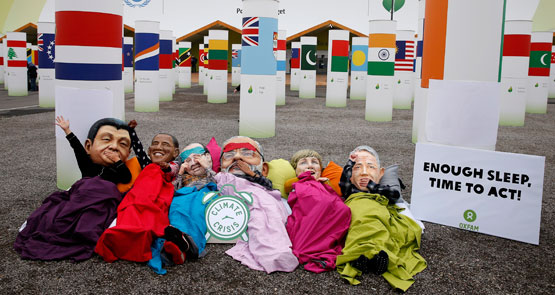
Demonstrators dressed as world leaders protest outside COP21
Another draft of the final COP21 climate agreement is out. There were a lot of bleary eyes at the conference centre today after negotiators worked through the night. Parties first met as a cohort to give “indaba” responses to the draft released yesterday, and then split up to smaller groups to hash out the areas that will need more work to find consensus.
“Indaba” refers to a process where each member at the table gets to speak and be heard. The inclusive process has a Zulu name that first appeared in the 2011 Durban meeting. That meeting provided the key breakthrough that recognised that all countries, including China and India, would offer broad climate action commitments. The Kyoto model, where only developed countries make emission reduction commitments, formed the basis pf a major argument used by some against the UN process and climate action more generally.
Among the usual lamentations about the exhausting negotiation process, there were also murmurs of agreement that yesterday’s text was an improvement. But not everyone saw their priorities in there yet.
As Thursday has now drawn to a close with a text that is mostly clear of square brackets (which highlight disagreements or alternative options). It suggests broad agreement on a range of issues but the following remain clearly contested:
- how to build a common system of transparency for country actions;
- how to address unmanageable climate change impacts in vulnerable nations; and
- how to financially support poor nations participate in climate change solutions.
This is a strong, carefully balanced text. It includes the formal review and updating of targets every five years starting, in 2019. This would be done against the reference to limiting global warming below 1.5-2oC by the end of the century and achieving net zero emissions or ‘emissions neutrality (the science on this suggests all greenhouse gases would need to be at net zero by 2050 to have a chance at 1.5°C and between 2060 and 2070 for 2°C. CO2 emissions from energy and industry, which last longer in the atmosphere, would need to be at zero earlier than other gases). Finance contributions would be scaled up to the poorest and this would be tracked through time.
There are a number of challenges in here for Australia, which will need to recognise that its pollution reduction targets are more aligned to 3 to 4 degree warming and would leave us with the petro state of Saudi Arabia as the highest per capital polluters in 2030.
However, this text is not the final agreement. With a desire to present a penultimate version in the morning and make history by closing the meeting on time, with a final agreement Friday evening Paris time, the French president of the COP has called for “solutions indabas”.
The journey to where we are now in Paris has been a long and difficult one; ministers could still tumble at the final hurdle.







It can’t be denied that the Climate Change Comics are far better at quaintly absurd humour than they will ever be at understanding the issues involved in Climate Change.
Grandchildren await . . with clenched fists!
Think of the T/A being racked up! As with all these jawfests, i wonder how many 3rd Worlders will apply for asylum and forget to rejoin their delegations, back to whatever hell hole they escaped?
We still have double figures from the 2000 Olympics.
You say, “the science on this suggests all greenhouse gases would need to be at net zero …. to have a chance at 1.5°C and … 2°C.” Almost but not quite. Perhaps the speaker you were quoting has been lazy in his or her choice of words.
We need more precision here. In fact it is the concentration of greenhouse gases that would need to be constant, obtained only by cutting the rate of emissions to zero, if we are to trend towards any equilibrium temperature. Depending on when we could achieve a zero rate of emissions, the equilibrium temperature could level out at 1.5° or 2° etc.
Although an atmospheric chemist might be able to duck and weave as spin doctors try to cheat him or her into denial, a journalist may not. The person in the street deserves a clear distinction between the two terms. It would help us all if journalists restricted the word “emissions” to the phrase “rate of emissions” while at the same time restricting the term “greenhouse gases” to the phrase “concentration of greenhouse gases”.
That way, we readers would know and you’re talking about the thing that is sick (concentrations in the greenhouse) or the activity (non-zero rate of emissions) that is making that thing sicker.
When all the gloss is gone,,, when all the backslapping has finished,,, when all the dust has settled and all the spin, smoke and mirrors have been scraped away ,,,,,, what will we be left with ? Yes, WHAT ?
What effective action has been initiated ? I mean action which really will achieve a substantial reduction in pollution next week. I mean substantial action which will start NOW, and not weak political promises which may happen “soon”.
I hope I’m wrong, but I feel the outcome may look something like this cartoon . . . . . . .
https://cartoonmick.wordpress.com/editorial-political/#jp-carousel-205
Cheers
Mick